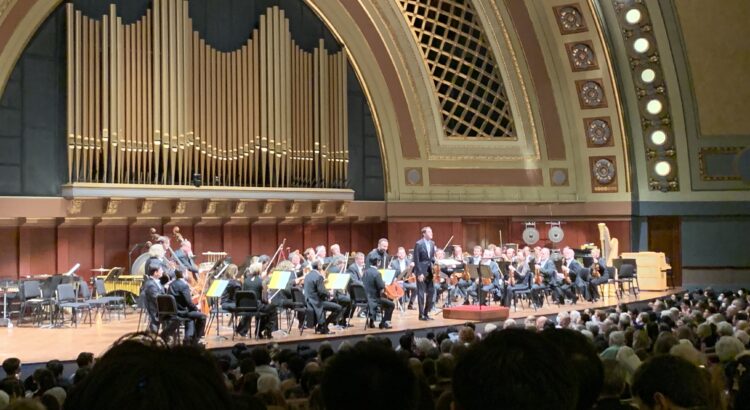One thing my childhood piano teacher of twelve years always told me was that a good performance made you feel taken care of. If you feel nervous on stage, so does your audience. If you are comfortable, the natural rise and fall of the music emerges and your listeners can comfortably breathe along each phrase.
Last Friday, I had the pleasure of seeing the Berlin Philharmonic play at the Hill Auditorium. Pen and notebook in hand, I was reminded of my teacher’s words when the pages stubbornly remained relatively blank. When faced with the golden standard of the orchestral world, I suddenly found it very difficult to come up with any constructive comments. For the concert’s two-hour duration spanning raucous 21st-century sounds to Mozart’s pristine motifs, all I could do was sit back and think: this is so nice.
As the orchestra members made their way to their seats, I was surprised to see the second violins and cellos settle down in each other’s usual sections, with the basses gathered on the left side of the stage behind the cellos. While this seating arrangement made sense for the Mozart concerto later in the program, it was interesting to hear it used for Unstuck, a recent composition by Michigan native Andrew Norman. It is difficult to describe what happens in the piece–eerie, yet beautiful melodies are sandwiched between messy, frantic climaxes. Blurry tutti slides carry the listener from one idea to the next to the point where you forget where the piece even started. I rarely get a good view of the basses when I watch concerts, but this time around I was able to observe how they were constantly employed to add subtle, textural elements–slaps, snaps, dry scrubbing–to the ensemble.
Next up was the Mozart Violin Concerto No. 1 in B-flat Major performed by concertmaster Noah Bendix-Balgley. I don’t typically listen to Mozart over other composers, but Bendix-Balgley’s interpretation felt like a return to the fundamentals and allowed me to appreciate his music. His solo part was impeccably clean and sweet with a bell-like quality. The hardest part of playing Mozart is to make it sound effortless–both the ensemble and soloist mastered this element. The candenzas, written by Bendix-Balgley himself, were complex and brilliant.
Concluding the concert was the Korngold Symphony in F-Sharp Major. There is a lot of discourse surrounding Korngold and his validity as a serious composer due to his career writing music for films–an argument I find silly. The cinematic lushness and bold tuttis give the piece a distinct mood, while the free-spirited clarinet solo at the beginning of the first movement introduces an engaging story of conflict and resolution throughout the work.
Part of the reason why the Berlin Phil is able to produce such a distinct sound is the combination of intense coordination and soloistic playing. By matching the exact speed and positions of each bow, the strings are able to meld together and mask any sense of bowings. I can only hope that everyone could have the chance to hear them perform live because it is truly a magnificent experience.


